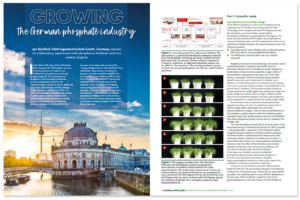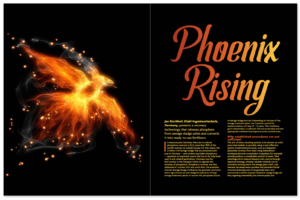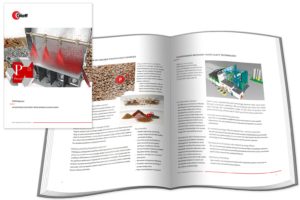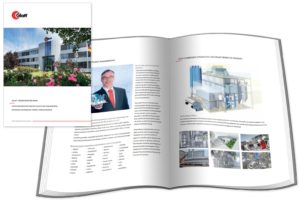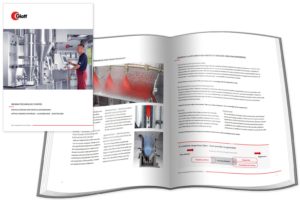Glatt PHOS4green for
Utilization of
local phosphate
resources.
100%
recycling.
No waste.
Sustainable
alternative to
mineral fertilizers.
Ecological
closing of
the nutrient cycle.
Phosphorus – an irreplaceable nutrient
Phosphorus is an important raw material for the manufacture of a variety of phosphorus-containing products for use in industry and agriculture. Above all, phosphorus is an important nutrient for crops. Without phosphorus, they cannot grow.
Fertilizers and animal feed account for the largest share of global phosphorus consumption.
Proven phosphorus reserves are declining sharply worldwide. There are no significant deposits within the European Union. The EU Commission even classifies phosphorus as a critical raw material. Phosphate is a required material for the production of fertilizer and intensive agriculture is not possible without phosphate fertilization. Germany currently sources most of its requirements from phosphate deposits in Morocco and the western Sahara.
Die Phosphor-Krise – Das Ende der Menschheit’ (Documentation on YouTube)
Utilization of valuable, local phosphate resources from sewage sludge
Organic residues such as sewage sludge, farm manure such as liquid manure and dung, and fermentation residues are a cost-effective and sustainable alternative to mineral fertilizers. It therefore makes sense to gradually replace phosphorus imports, which are limited in quantity. Around two million metric tons of sewage sludge mass, which municipal wastewater treatment plants extract from Germany’s wastewater every year, are available for recycling. They contain around 60,000 metric tons of phosphorus.
Avoidance of over-fertilization and reduction of pollutant loads in groundwater and the food chain
The direct application of sewage sludge is increasingly criticized. The uncontrolled spreading of the solids from the sewage treatment plant on the fields makes fertilizer mineral content inconsistent and unreliable. The phosphate content in the sludge is too variable and results in under or over fertilization. Soil-related utilization of sewage sludge pollutes groundwater and bodies of water, and harmful pollutants enter the food chain via crops. In addition to heavy metals, these include undecomposed drug residues and synthetic polymers. The latter is a type of microplastic that is used in sewage treatment plants, for example, to destroy the membranes of bacteria. This makes it easier to mechanically dewater solids and bacteria from biological treatment stages.
Two legal regulations prohibit the application of sewage sludge directly to the field in the future. On the one hand, the German Fertilizer Ordinance (DüMV) and the and Regulation EG No. 2019/1009 considerably limit the amount of synthetic polymers that do not sufficiently degrade themselves in sewage sludge. On the other hand, sewage plant operators are being forced to rethink their approach due to a revision in the Sewage Sludge Ordinance (AbfKlärV) of October 2017. Phosphorus recovery from sewage sludge with more than 20 grams of phosphorus per kilogram of dry matter will be mandatory from 2029 on in sewage treatment plants with more than 100,000 population equivalents. After 2032, this will also apply to smaller wastewater treatment plants with a population equivalent of more than 50,000.
Circular value creation through ecological closing of the nutrient cycle
The options for phosphorus recovery currently consist of separating the phosphorus directly from the sewage sludge or from the ashes of a sewage sludge incineration. For this purpose, sewage sludge may no longer simply be burned along with the sludge in cement plants or waste incineration plants, for example, as has been the case in the past. These processes bind the phosphorus in the slag or clinker and it is therefore lost.
Sewage sludge should primarily be fed into mono-incineration. What remains is ash with a high concentration of phosphorus. This must be separated. Phosphoric acid, fertilizer, calcium phosphate or calcium ammonia can be obtained from this ash by wet chemical processes. In thermochemical processes an alkali salt is added to the ash at a temperature of around 950 °C. In this way, heavy metals can be removed. This allows heavy metals to be separated and expelled in the waste gas stream.
Phosphorus recycling from sewage sludge ash to meet plant- and soil-specific nutrient needs through PHOS4green
In the first step, the process developed by Glatt releases phosphorus from sewage sludge ashes and uses fluidized bed spray granulation to produce ready-to-use, low-pollutant standard fertilizers. No waste is generated in the process. 100 percent of the ash is recycled.
Glatt PHOS4green. Phosphorrecycling: Düngerherstellung aus Klärschlammaschen.
Excerpt from the MDR – program “ECHT
Title: “Das Geschäft mit dem Geschäft – Klärschlammverbrennung im Geiseltal.”
from Dec. 4, 2019. Broadcast time: 9:15 p.m. to 9:45 p.m.
Licensor: Bavaria Media GmbH
With the PHOS4green process, Glatt makes a decisive contribution to environmental protection.
To improve our performance, we operate an environmental management system in accordance with DIN ISO 14001.
Use our PHOS4green process to sustainably close the nutrient cycle and as an economical solution for meeting the legal requirement to recover phosphorus.
Further information on this topic and related topics can also be found in the following publications:
Published article: ‘Growing the German phosphate industry’. PDF, English
Technical article: ‘Like a phoenix from the ashes’. A recovery technology that releases phosphate from sewage sludge ashes and converts it into ready-to-use fertilizers. PDF, English
Flyer A4: Glatt PHOS4green, PDF, English
Flyer A4: Glatt Ingenieurtechnik, PDF, English
Brochure A4: Glatt Technology Center Weimar, PDF, English


